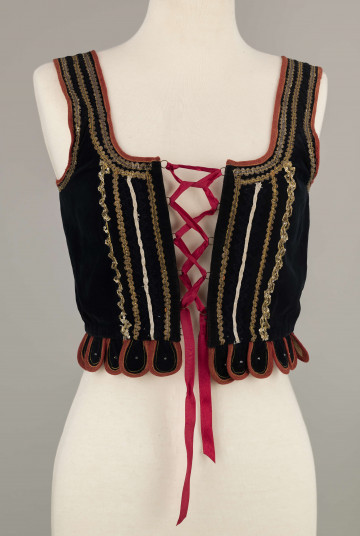
Corset
1895
National Museum in Lublin
Part of the collection: Folk craft of the Lublin Region (19th/20th c.)
The men's shirt is almost entirely made of linen, woven in a plain weave, and only the so-called bodice is made of factory cotton. It was machine-sewn before 1914 and comes from Sułoszyn in the Lubartów region; the maker is unknown. It has a shoulder cut with a yoke. It is composed of five rectangular pieces of fabric, the two largest ones form the front and back of the shirt (length 85 cm, width 60 cm) and were joined together by a so-called border, i.e., a narrow strap gathering the two panels at the top. The other two pieces were used to make long sleeves (57 cm), which are bound at the bottom, near the hands, by a wider cuff (length 24 cm, width 4 cm) fastened with a single button. A triangular gusset, known as an insole, is sewn under the armpits. The neckline is finished with a collar of white factory linen fastened with a single button. The front slit, 26 cm long, is fastened with two buttons and finished with a 4.5 cm wide fold at the bottom.
At the beginning of the 20th century, shirts with a yoke, sewn from linen canvas with inserts from white cotton linen or in delicate stripes, with a small stand-up collar, cuffs and bodice, called a front, became popular. At that time, men wore waistcoats and jackets for festive and ceremonial wear, so only the cotton parts were visible underneath. These shirts sometimes had interchangeable buttoned collars. Some seamstresses cut teeth along the slit and at the sleeve seams for decoration, which they sewed with white thread.
Author / creator
Dimensions
cały obiekt: height: 60 cm, width: 85 cm
Object type
shirt
Technique
machine sewing
Material
flax, canvas, buttons
Creation time / dating
Creation / finding place
Owner
The National Museum in Lublin
Identification number
Location / status